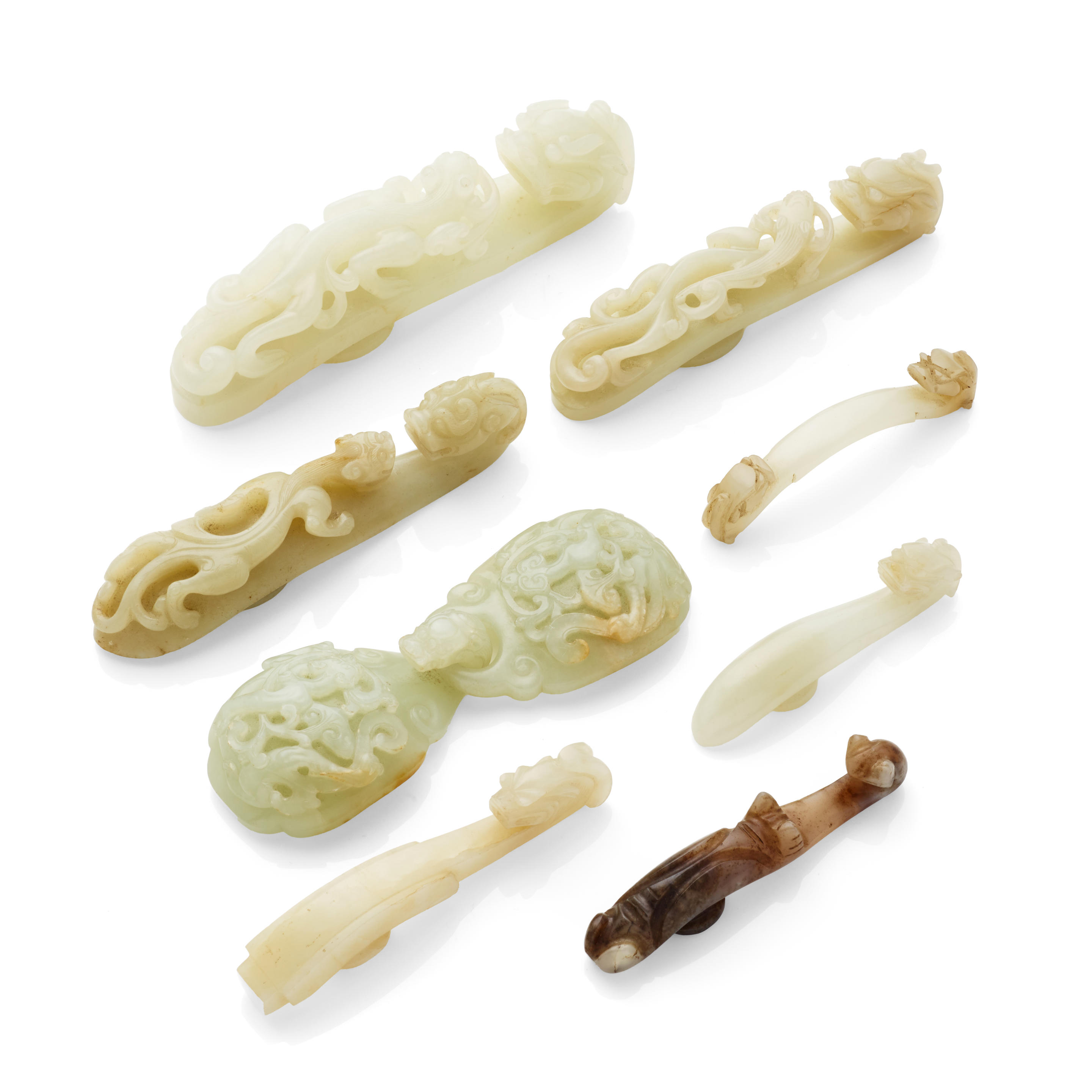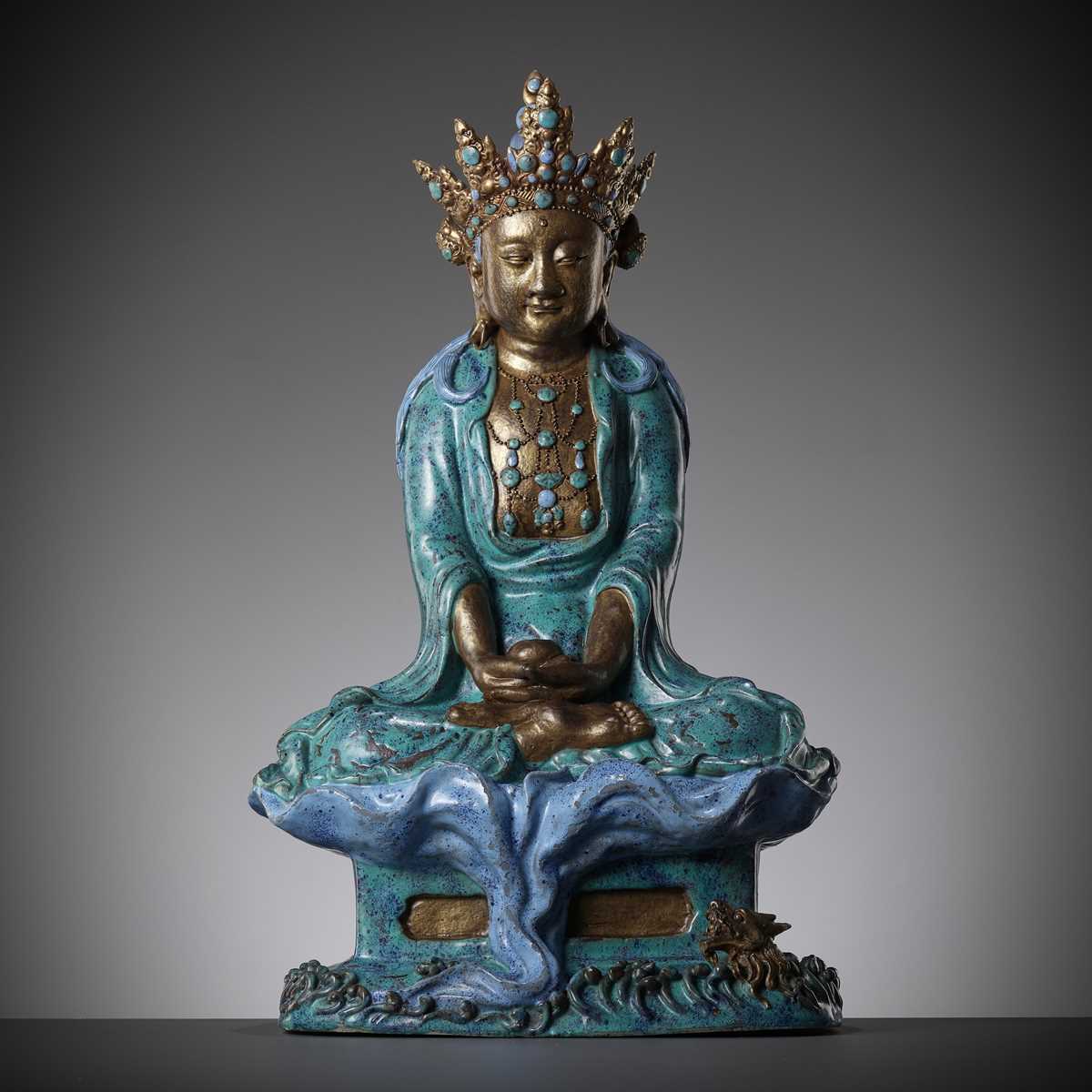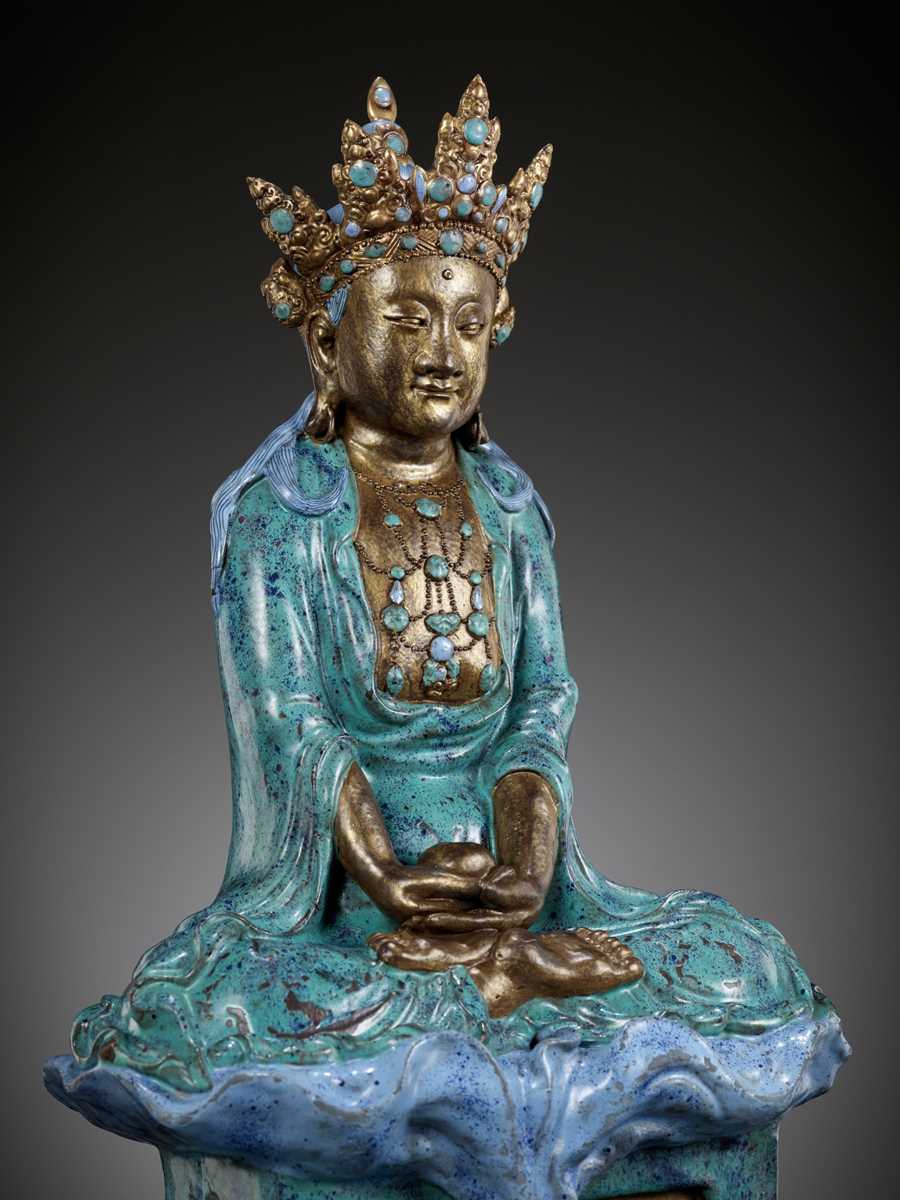AN UNUSUAL ARCHED DRAGON-SHAPED ORNAMENT IN OPENWORK WITH A FINE POLISH Katalognummer: JAK0318-030 Jade China Eastern Zhou, late Spring and Autumn period, 5th century BC 鏤空龍鳳紋玉璜 - 東周, 春秋, 公元前5世紀 LENGTH 9.3 CM - WIDTH 5.1 CM 長 9.3 厘米 - 寬 5.1 厘米 The shape of this ornament is formed by two dragons that share the same body, similarly to the so-called huang 璜, or arched pendants (see the following lot, no.31). However, in this case the heads of the dragons turn backwards and face one another: their snouts are connected by a central pointed element with a cut-out below that forms the main suspension hole, balanced at the bottom by a curved segment joined to the body of the dragons. This bottom arch and the four additional small holes drilled in the mouths and in the paws of the animals suggest that this pendant was most likely part of a set of ornamental jades that were strung together. The facial features of the dragons –the bold snouts, round eyes, crest and teeth- are delineated by incised curved lines. The body is decorated with typical patterns of the Spring and Autumn period: rows of c-scrolls and a pair of stylized dragon heads in profile carved at the centre of the arched body. The lovely translucent pale green jade is highly polished, but the majority is covered with a chalky white patina that has rendered it opaque. This rather unusual type of ornament does not have exact matching examples in excavated jades of the Eastern Zhou period, but there are later Han period huang that display a similar type of design. See, for example, one found in a Western Han tomb near Mangshan town in Yongcheng district, Henan province, illustrated in Yang Boda (ed.), Zhongguo yuqi quanji: 3, Chunqiu Zhanguo 中 国玉器全集/3/春秋战国 (Chinese Jades: 3, Spring and Autumn and Warring States), Hebei 1993, no.178; and a second pendant from an Eastern Han tomb excavated near Dingzhou city, Baoding prefecture, Hebei province, reproduced in Gu Fang, Zhongguo gu yuqi tu dian 中國古玉器圖典 (The pictorial handbook of ancient Chinese jades), Beijing 2007, p.239. Compare also an Eastern Han pendant published in the auction catalogue Galerie Zacke, Archaic and Antique Chinese Jades, 2 December 2017, no.35. Startpreis 起始價: € 3.200 Schätzpreis 估計/估算: € 6.400 Expertise: Prof. Filippo Salviati From an Austrian collection All jades in this catalogue have been professionally examined, authenticated and described by Prof. Filippo Salviati. Professor Salviati teaches Chinese and Korean art at Sapienza University in Rome, in the Italian Institute of Oriental Studies. He is a world expert on archaic Chinese jades, having released multiple publications and being cited by renowned auction houses such as Sotheby’s. The microscopic images made available here, show that the weathering of the jade has occurred over a long period of time. Furthermore in the magnification one can reconstruct the workings of the jade. The two aforementioned criteria are exactly what counts in the authentication of archaic jades – the difficult and elaborate workmanship by hand and the subsequent weathering of the jade over centuries. The microscopic enlargements show how the patterns were ground out in many small steps, sometimes over months, and that the weathering actually occurs above the carvings, meaning it occurred after the jade was completed.
AN UNUSUAL ARCHED DRAGON-SHAPED ORNAMENT IN OPENWORK WITH A FINE POLISH Katalognummer: JAK0318-030 Jade China Eastern Zhou, late Spring and Autumn period, 5th century BC 鏤空龍鳳紋玉璜 - 東周, 春秋, 公元前5世紀 LENGTH 9.3 CM - WIDTH 5.1 CM 長 9.3 厘米 - 寬 5.1 厘米 The shape of this ornament is formed by two dragons that share the same body, similarly to the so-called huang 璜, or arched pendants (see the following lot, no.31). However, in this case the heads of the dragons turn backwards and face one another: their snouts are connected by a central pointed element with a cut-out below that forms the main suspension hole, balanced at the bottom by a curved segment joined to the body of the dragons. This bottom arch and the four additional small holes drilled in the mouths and in the paws of the animals suggest that this pendant was most likely part of a set of ornamental jades that were strung together. The facial features of the dragons –the bold snouts, round eyes, crest and teeth- are delineated by incised curved lines. The body is decorated with typical patterns of the Spring and Autumn period: rows of c-scrolls and a pair of stylized dragon heads in profile carved at the centre of the arched body. The lovely translucent pale green jade is highly polished, but the majority is covered with a chalky white patina that has rendered it opaque. This rather unusual type of ornament does not have exact matching examples in excavated jades of the Eastern Zhou period, but there are later Han period huang that display a similar type of design. See, for example, one found in a Western Han tomb near Mangshan town in Yongcheng district, Henan province, illustrated in Yang Boda (ed.), Zhongguo yuqi quanji: 3, Chunqiu Zhanguo 中 国玉器全集/3/春秋战国 (Chinese Jades: 3, Spring and Autumn and Warring States), Hebei 1993, no.178; and a second pendant from an Eastern Han tomb excavated near Dingzhou city, Baoding prefecture, Hebei province, reproduced in Gu Fang, Zhongguo gu yuqi tu dian 中國古玉器圖典 (The pictorial handbook of ancient Chinese jades), Beijing 2007, p.239. Compare also an Eastern Han pendant published in the auction catalogue Galerie Zacke, Archaic and Antique Chinese Jades, 2 December 2017, no.35. Startpreis 起始價: € 3.200 Schätzpreis 估計/估算: € 6.400 Expertise: Prof. Filippo Salviati From an Austrian collection All jades in this catalogue have been professionally examined, authenticated and described by Prof. Filippo Salviati. Professor Salviati teaches Chinese and Korean art at Sapienza University in Rome, in the Italian Institute of Oriental Studies. He is a world expert on archaic Chinese jades, having released multiple publications and being cited by renowned auction houses such as Sotheby’s. The microscopic images made available here, show that the weathering of the jade has occurred over a long period of time. Furthermore in the magnification one can reconstruct the workings of the jade. The two aforementioned criteria are exactly what counts in the authentication of archaic jades – the difficult and elaborate workmanship by hand and the subsequent weathering of the jade over centuries. The microscopic enlargements show how the patterns were ground out in many small steps, sometimes over months, and that the weathering actually occurs above the carvings, meaning it occurred after the jade was completed.














Try LotSearch and its premium features for 7 days - without any costs!
Be notified automatically about new items in upcoming auctions.
Create an alert